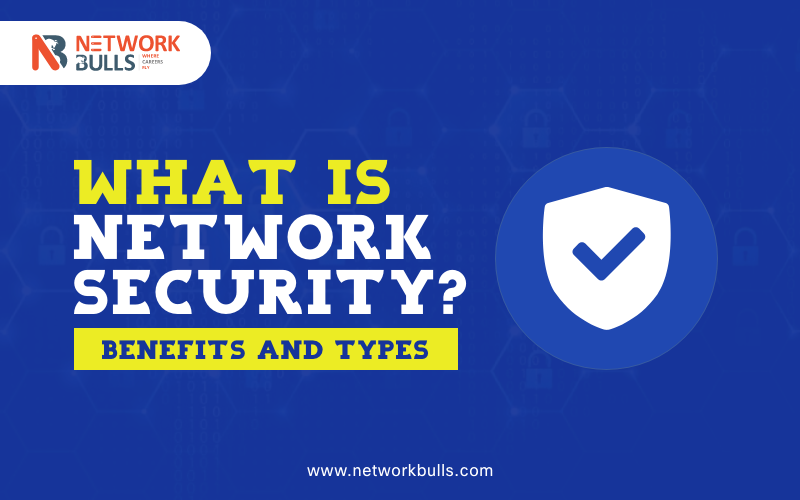What is Network Security? Benefits and Types

Network security is the core concern of all enterprises in view of the continuous efforts by hackers to hack data and information or disable computer networks.
To get an answer to what network security is, you have to get into the details of the security steps taken to protect the network against repeated attempts by cybercriminals to intrude into the network to steal data.
What is Network Security? Benefits and Types
Network security means securing a network against breaches. It involves:
-
hardware and software solutions,
-
Processes, protocols, and rules to secure the network and
-
Configurations related to the use of the network, its accessibility, and protecting against threats.
Technically speaking, securing a network can be ensured by the following scientific and digital means:
-
Access control
-
Virus and anti-virus software deployment
-
Application security
-
Network analytics
Benefits of Network Security
If you want to seamlessly avail yourself of the benefits of running your network without facing any breaches, hassles, or disruptions, you have to secure your network.
There are many benefits to network security. Here are five major benefits of network security:
-
Data Protection (corporate information, confidential company matters, and client data, among others)
-
Maintaining shared data secure
-
Ensuring reliable access
-
Ensuring seamless network performance
-
Securing the network from cybercriminals and
-
Stopping unauthorized third-party intrusion into the network.
Apart from these benefits, the deployment of well-designed network security solutions can also substantially cut overhead expenses and enable an enterprise to protect the system from data breaches. This will also help you to protect corporate confidentiality while ensuring service delivery by streamlining it.
Types of network security
There are different technological and digital types of network security. If you deploy them, you can secure your network. These types of network security are explained below:
Firewall: This is quite an effective security step you should take to protect your network. Besides controlling traffic—both outgoing and incoming—it can protect the application layers of your network and block the entry of viruses and malware into your computer network system.
Network Segmentation: It functions in the following manner:
-
Defines boundaries between the network segments where data, information, and assets within the group have an identical function, risk, or role within an enterprise.
-
Perimeter gateway segments the network of an enterprise from the Internet.
-
It prevents threats outside the network.
-
Ensures that sensitive information and data remain inside an enterprise network and
-
Improves security and access control.
IPS: The Intrusion Prevention System (IPS) has the capability to detect and prevent security attacks. It can foil unauthorized attempts by third parties to exploit known weaknesses or vulnerabilities, including software systems. By exploiting these weaknesses, the hacker can make unauthorised entry to steal data.
Identity and Access Management (IAM) is a type that can exactly identify network users and groups to allow them access control. It can deny access to unknown entities. Another system, RBAC (role-based access control), can also very efficiently manage and control access.
-
Remote Access VPN: This can safeguard an enterprise network. It enables remote and secure access to an enterprise network to individual hosts or clients like telecommuters, mobile users, and extranet consumers.
-
ZTNA (Zero Trust Network Access) : This can ensure network security to a great extent. Also known as SDP (Software-defined Perimeter), the ZTNA works on the principle that a user should only have the access and permissions that they require to fulfil their role. The modus operandi of ZTNA vary from that of the VPN.
-
Email Security: This is designed to protect your email accounts and email content from hackers.
-
DLP: A data loss prevention (DLP) system prevents the exposure of data outside of a company, enterprise, or organisation.
-
Sandboxing: Sandboxing allows you to use code to open files. It does so in a safe and isolated environment. Files are opened only after the code is entered.
-
Hyperscale Network Security: This is a smart security method. Hyperscale can be deployed to face multiple network risks by tightly integrating network and compute resources in a software-defined system.
-
Flexible Cloud Network Security: The cloud is another way to safeguard and secure your network. For this, SDN (software-defined networking) and SD-WAN (software-defined wide area network) methods can be of great use.
These are the most important types that can be deployed to secure a network.
Network security course
As a networking professional, you must complete a network security course like:
-
CCNA: Introduction to Network and
-
CCNA: Switching, Routing, and Wireless Essentials.
These courses will enable you to gain a total understanding of network security vis-à-vis the threats faced by networks. By completing these courses, you can design, implement, and support security for networked devices and data.
Network security institute in India
There are a large number of network security institutes in India. But you have to zero in on the one that has the in-built capability to make you a security expert through training and exposure to the lab. Your right choice should be the Network Bulls of Gurgaon. An award-winning network training institute, the Network Bulls, can help you hone all the skills required to become a security specialist.
Conclusion
Network security, unless made strong, versatile, and robust, can allow viruses and worms to corrupt your system and allow illegal third-party intrusion. The entry of Trojans, spyware, adware, malware, and ransomware must be stopped to fully secure your network.
Also Check this :
- RECOMMENDED POSTS
-
Network Bulls Placements (53)

-
CCIE (101)

-
CCNP (32)

-
CCNA (40)

-
Awards (14)

-
Network Bulls Reviews (53)

-
Informational Articles (74)

-
Technical Articles (26)

-
CCIE Success Stories (40)

-
Summer Training Courses (5)

-
CCIE Security Version 5 (34)

-
CCIE Data Center (19)

-
MCSE (3)

-
Industrial Training (10)

-
Microsoft Certification (3)

-
Ask NB (7)

-
Network Bulls Offers (6)

-
Best Institute for CCIE Training in India (118)

-
CCIE Training Courses (78)

-
DHCP (2)

-
Webinars (6)

-
Training (127)





















